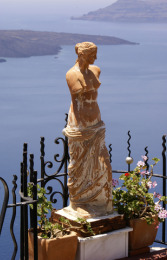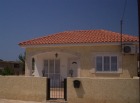The Incredible History of Cyprus
Cyprus History
The history of Cyprus is truly fascinating. From the Neolithic Era to the present day.

Colonized and ruled many times over the centuries, Cyprus is one interesting country in Europe that was beset with a complicated historical line of various rulers and political leaderships.
Yet the history of Cyprus remains one of the richest in the world amidst its unique culture, ancient works of arts and architecture, and large deposits of copper.
Cyprus is the third largest island in the Mediterranean with a total land area of 3,571 square miles and a total population of 796,740 as of 2009.
The island is situated between Turkey's southern coast and Syria's western shores,
The Neolithic Era
The pre-pottery history of Cyprus, namly the Neolithic B era in 8,500 to 8000 B.C. saw the hunter-gatherers and agriculturists as the first human settlers in the island with the sheep, pigs, cattle, and goats as the first animals introduced around this time.
In 6th millennium B.C., the aceramic Khirokitia culture saw the development of the roundhouse stone vessels, the cattle disappearance, while the Persian fallow deer was introduced and hunted for its meat.
Soon stone figurines were discovered during the following ceramic Sotira phase.
But two of the most fascinating archeological finds under the history of Cyprus dated between 9,000 to 10,500 years old were water wells and an ancient grave of a man buried alongside his cat.
These findings gave proof of the early settlers' history of early civilization and close connection with his natural environment that began in the Stone Age period.
The Rule of Pottery - 7,000 to 5,300 B.C
Cyprus history is filled with the rich cultural heritage brought by ancient pottery. Pottery started in the island from 7,000 to 5,300 B.C., earliest artifacts of which can still be found today in Cyprus' numerous museums and private collections.
This practice, which largely contributed to the identity and way of life in the island and its people, flourished for many centuries.
Individual pottery styles began from 2,700 to 1,600 B.C. Large-scale exportation to Egypt, Levant and from one part of the island to the rest opened the gates for commerce and trade between these countries.
Also among the people in the island from 1,600 to 1,050.
Because these ancient artifacts were handcrafted, the individual potter's style was highly ornate and always original.
This elevated their marketability and common functions as water or food containers or cook wares in the Late Bronze era.
Today, these ancient artifacts are also valued for their high artistry and cultural representation of the country's early civilization.
The Isle of Kupros
Owing to its rich deposits of copper, Cyprus became Mediterranean's largest producer of copper which began in the Early and Middle Bronze Ages when artifacts and common household tools like mirrors, razors, pins, axes, chisels and various ancient weaponries like spears and knives were either wholly or partially made in copper.
It is also believed that because of the great abundance of this natural metal and its usefulness to the people, the island's name was derived from its Greek name, Kupros.
Cyprus is believed to have produced over 200,000 tons of copper and the island's international role for the production and trade of this metal became more apparent after the shipwreck of Ulu Burun, which sank off Turkey's southwestern coast sometime in the late 14th century B.C., was discovered to have carried copper ingots over ten tons.
The major centers Kition, Hala Sultan Tekke, Enkomi, Palaeopaphos, and Maroni, like the smaller towns such as Tamassos, Idalion, Kalavasos-Ayios Dhimitrios, and Alassa, were the known copper-producers of the island.
Copper also became a major tool of power and control for the ancient rulers and leaders in cyprus history. With the passing of the Bronze Age and rule of the Iron Age, copper was still highly produced with Phoenicians and Persians taking control of the mine-producing centers in Tamassos and Idalion.
Later, the Ptolemies, Hellenistic leaders of Egypt in 330 A.D., came in and set about putting their own people to control the production. The Romans followed by leasing these mines at the highest cost.
Architecture and Colonization
The history of cyprus is also filled with a long line of tragedies, both natural and man-made.
Achaean Greeks were the first colonizers of Cyprus from the 12th and 11th centuries B.C. and built the cities of Salamis, Kition, and Paphos.
While the 8th century B.C. in the history of Cyprus saw the economic rise of the island, Assyria, Egypt, and later on, Persia, conquered the island one after the other. King Evagoras of Salamis, who desired the continued unity of the island by rebelling against Persia's rule, was thwarted.
The Macedonian king, Alexander the Great turned the tide of battle against Persia and conquered Cyprus in 333 B.C which forged the Hellenic and Cypriot bond.
Yet, following his death, the island was ruled by the Ptolemies of Egypt under the Greek Alexandrine world.
Roman Emperor Caesar, seeing no difficulty in the administration of the island "returned" it to the Egyptians in 47 B.C. to the beautiful Cleopatra. In 36 B.C., Marcus Antonius, commonly known as Marc Antoni, repeated this act as a "generous gift" to his beloved Cleopatra.
Earthquakes, which tore down whole cities each time, took place between the 1st century B.C. and the 4th century A.D. in the history of Cyprus, when the Roman Empire seized and ruled the island.
By 330 A.D., Cyprus came under the Eastern Roman Empire of Constantine the Great. New cities were built and large basilicas were erected from the 4th to the 5th century A.D.
More invasions and colonizers came: the Arabs in 647 A.D., pirate attacks until 965 upon Emperor Nicephoros Phocas' expulsion of the Arabs from the island and Asia Minor.
While King Richard the Lionheart of England who arrived in 1191 was said to capture the island in anger toward Byzantine Emperor Isaac Comnenus who did not let his future wife, Berengaria of Navarre, tossed in the ship in the middle of a storm, to fetch for water ashore. Richard arrived in Limassol and attacked the Cypriot forces.
Frank Guy de Lusignan followed in 1192, the same period when there came the rise of beautiful architectural structures like the Cathedrals of Ayia Sophia in capital Nicosia, the Bellapais Abbey, and Saint Nicholas in Famagusta. Queen Catherina Cornaro ceding of Cyprus to Venice in 1489 marked the end of the Lusignan dynasty.
The Turkish Occupy Northern Cyprus
Today, Turkey occupies over thirty-five percent of the island after its renewed invasion in July 1974 which led to about 200,000 Greek Cypriots becoming refugees in the occupied territories.
The United Nations General Assembly, the Commonwealth and the Council of Europe, and the Non-Aligned Movement, continue to condemn and call to stop the basic human rights violations on the people of Cyprus.
Visit Cyprus and see for yourself some of the incredible historical buildings, sites and traditions.
Learn about Archaeological Sites in Cyprus
Top of History of Cyprus
Go to Home Page
Best Links
Coffee Bar
Business for Sale in Cyprus

Agia Thekla Villa
Private Resale

Cyprus Bungalow for Sale

You Can Build a Travel Site Too!














